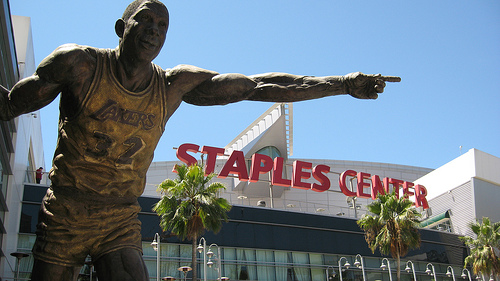- You are here:
- Home »
- Blog »
- Basketball »
- The Tallest Point Guards in NBA History

The Tallest Point Guards in NBA History
The allure of a big point guard is obvious. Their size advantage can make them a versatile threat who can be a nightmare to defend. The downside is that they usually have to defend smaller, quicker players who can also be pesky defenders.
The tallest point guards in the NBA were able to overcome these disadvantages and use their height advantage to be dynamic playmakers that present a challenging matchup. Who were some of these players?
All-time – Earvin “Magic” Johnson
Today – Shaun Livingston
For arguments sake, I’m only considering tallest true point guards to play. So somebody like LeBron James, who occasionally plays some point guard, but starts at small forward and spends most of his minutes elsewhere, doesn’t count. I’m listing players who have been starters at point guard for significant stretches of their career.
Magic Johnson
Height – 6’9″
Years in NBA – 1979 – 1991, 1996
Earvin “Magic” Johnson isn’t just the tallest point guard in NBA history, but one of the greatest players of all time, regardless of his height or position. Standing at 6’9″ and playing the majority of his career at point guard, though, makes him one of the most unique NBA players of all-time. For his career, he averaged 19.5 points, 11.2 assists, and 7.2 rebounds per game. Those are just awesome numbers, that few players have ever been able to approach for even a single season, yet he averaged them for a 13 season career with the Los Angeles Lakers.
Johnson’s stellar career included 3 MVP Awards, 12 All-star game appearances, 3 Finals MVP Awards, and 5 NBA Championships. Along with Larry Bird, he was crucial for growing the popularity of the league in the early 1980s. He spent his entire career with the Los Angeles Lakers and was the leader of the 1980s “showtime” Lakers teams. He retired before the 1991-1992 season, but returned to play for the Lakers late in the 1995-1996 season, primarily as a power forward.
Shaun Livingston
Height – 6’7″
Years in NBA – 2004 – present
Shaun Livingston was one of the most hyped tall point guard prospects in recent memory. This led to him being the 4th overall pick in the 2004 Draft after deciding to enter the league straight out of high school. He flashed his ability as a rookie, averaging 7.4 points and 5.0 assists for the Los Angeles Clippers in the 2004-2005 season. Unfortunately, he had multiple major knee injuries early in his career that slowed his progress. He has been able to reinvent himself and have a successful career, playing for multiple teams and helping the Golden State Warriors win the 2015 NBA Finals. You can see some highlights of Livingston in the video below.
Anfernee “Penny” Hardaway
Height – 6’7″
Years in NBA – 1993 – 2008
Penny Hardaway was an electric playmaker early in his career before struggling with injuries. He had a unique combination of size and ballhandling ability that hadn’t been seen at the position since Magic Johnson. He, along with Shaquille O’Neal, was a driving catalyst leading the Orlando Magic to the 1995 NBA Finals. In both the 1995 and 1996 seasons, Hardaway averaged over 20 points and 7 assists per game. Later in his career, he would play more time at the shooting guard and small forward positions. You can see a video of Hardaway in action with the Magic below.
Greivis Vasquez
Height – 6’6″
Years in NBA – 2010 – present
Greivis Vasquez is one of the few point guards in the NBA today to be above 6’5″. He showed his offensive ability with the New Orleans Hornets during the 2012-2013 NBA season, when he averaged 13.9 points and 9.0 assists per game. He has had mostly backup roles in recent years and his size and offensive skills allow him to play both point guard and shooting guard, depending on team needs. There is video of Vasquez below.
While you would think height could create a huge mismatch at the position, you rarely see many very tall point guards. 6’6″ and above is very rare at the NBA level. One reason potentially could be the defensive struggles they would have defending smaller, quicker players. If they don’t have the speed to stay in front of players like Stephen Curry and Chris Paul, they won’t be defending them. For this reason you’ll see some of the slower point guards play more time at shooting guard and small forward and only be used at point guard situationally.
The flip side of that is that the big point guards could take the smaller ones into the post. Their height can give them an advantage defensively also, also they could switch onto taller players at different positions. You could see cross matchups where they are defending shooting guards or small forwards. In pick and roll defense, they may be able to provide better defense if they switch onto a big.
Being a successful big point guards requires a unique combination of dribbling, passing, and quickness to be able to succeed at all aspects of the position. To go with their size, they need speed, quickness, and the defensive skills necessary to make a complete player.

